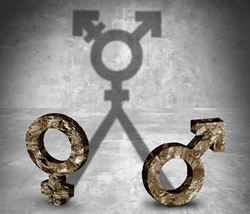Dr Pragya Agarwal* says more women are working than ever before, but gender stereotypes and biases continue to keep them from leadership positions.

Image: wild pixel
Today more women are working than ever before.
According to a recent survey, over 70 per cent of women aged 16–64 are employed, an increase from slightly over half (53 per cent) in 1971.
In 2014, almost as many women with children (74.1 per cent) participated in the labour force as women with no children (75 per cent).
When we look at the percentage of women in senior leadership roles, however, this has remained low, at 22 per cent in 2018.
So, what is happening in between the lower rungs to leadership positions as women progress through the ranks?
Why aren’t we seeing more women on boards, and in leadership positions when the workforce is evenly split at the entry level?
Lack of women in leadership means that women can often face more bullying in the workplace, the workforce is less diverse at the top, and the mental wellbeing of female employees can suffer as they feel discriminated against and do not have the same opportunities to progress.
The lack of women leaders also creates a paucity of role models who can inspire other women to enter and stay in the workforce.
Studies have shown that unconscious bias is rife in the workplace.
Gender stereotypes are everywhere.
It is in the language that we use, and it is the way we perceive women in the workplace.
Female leaders, in particular, can be affected by a double-bind bias or the problem of a mismatch between what is expected of a leader, and what is expected from a woman.
Psychology research has shown that there are two primary kinds of gender bias that affect women, called the descriptive and prescriptive bias.
Descriptive bias is the labels we attach and associate with certain social groups and communities, and prescriptive bias is how they are expected to behave.
And, when someone does not conform to these prescribed roles and behaviours they can be penalised or punished.
Women, for instance, are traditionally expected to be caring, warm, deferential, emotional, sensitive, and so on, and men are expected to be assertive, rational, competent and objective.
So, when it comes to promotion, these traits are sometimes automatically prescribed to people as per their gender without detailed information about their personalities, thereby a man, in general, is assumed to be a better fit as a leader.
The other side of this, prescriptive bias, is when a woman does not fit the role that is traditionally assigned to her and attempts to claim a traditionally male position and is seen as breaking the norm.
So, when a woman is decisive, she might be perceived as “brusque” and “abrupt”.
Therefore, for the same kind of leadership behaviour, women might be penalised while a man is commended.
This is the problem of “likability”, where women who are not assertive and fit the gender stereotype of a woman as being gentle and caring are liked more but not considered as leadership material.
On the other hand, women who display traditional “masculine” qualities such as assertiveness, forcefulness, and ambition are labelled as “bitchy”, unfeminine and aggressive, and hence generally disliked.
In both cases, women are then less likely to be promoted than a man.
Research has shown that when a man helps out in the workplace, he is acknowledged and appreciated, and if he does not, it does not matter much.
However, when a woman helps out, it is taken for granted, because that is her traditional role, and if she doesn’t, she is considered mean and unhelpful, character traits that are not assigned to a leader.
What can be done?
It is important that we are aware of these biases that can exist unknowingly, recognise and acknowledge them.
It is no point saying that we are all unbiased and unprejudiced because these are unconscious biases that are shaped by our cultural and social conditioning.
For both men and women, it is important to speak out and interrupt if you notice any remarks that demonstrate this kind of prejudice, such as “she is emotional” or “she is too talkative” or “she is not very caring”, as these can affect how competence is perceived, and these are not labels that would normally be assigned to men in the same situation.
Appropriate bias training is important for all members of staff so they are aware of not only their actions, but also the language and words that they employ.
Words, even when meant as a joke or banter, can create a feeling of mistrust rather than a positive workplace.
It is really important that we create a culture where we bring men into this debate and discourse as much as women, and men are seen as ambassadors for equality and female leadership.
Nevertheless, it is also important to consider that it is not just men who carry these biases, as women can discriminate against women, too, and penalise other women for being successful, or trying to be.
And, most importantly, employers and organisations have to take a closer look at their workplace policies and redefine what being a “leader” really means.
We need to actively work towards assessing the traditional gender norms, and the way we assign leadership qualities.
* Dr Pragya Agarwal is a social and creative entrepreneur and founder of The Art Tiffin. She tweets at @hedgehogprints.
This article first appeared at www.forbes.com.











